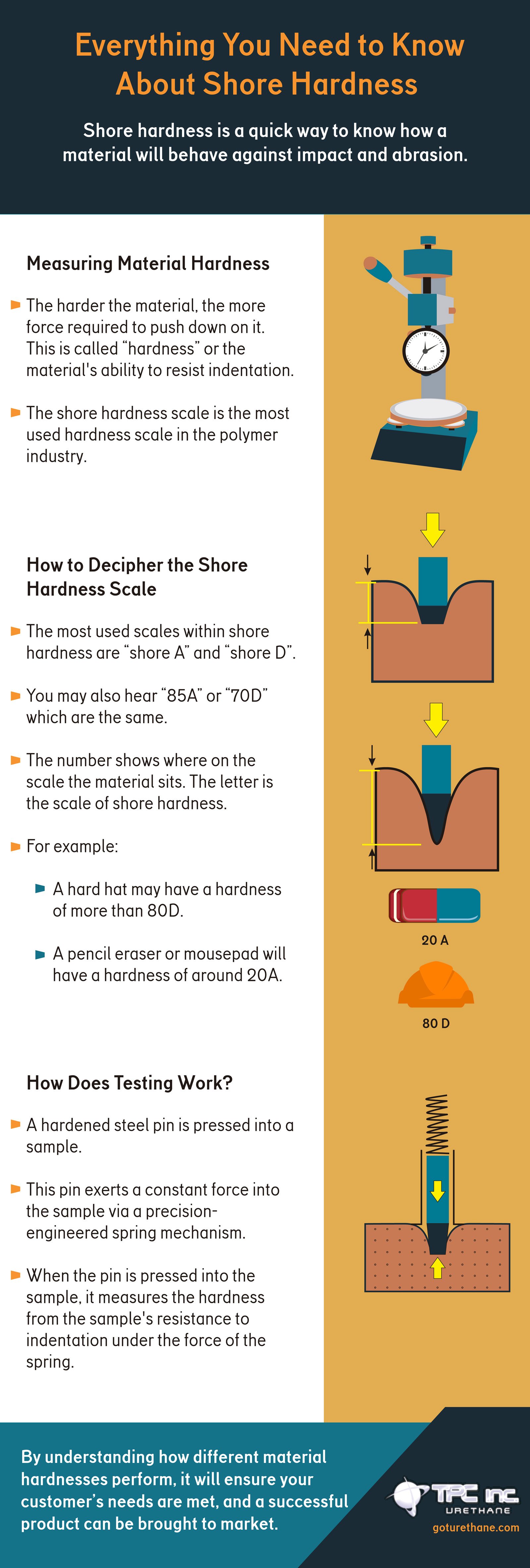The Shore Hardness Scales were created to provide a common reference point when comparing different materials. It is a measurement system that allows you to describe the properties of a material’s resistance to indentation, and in turn, how hard it actually is.
With the large selection available in polymers today, there are many technical specifications that can be used to illustrate the properties of a material. The amount of variability between the same compounds can further complicate this matter when trying to select the best material for your project.
Simply put, shore hardness is a quick way to get a general idea of how a material will behave against impact and abrasion.
Let’s go over how to decipher the shore hardness scale, how testing works, and more so you are prepared when it comes time to choosing the proper materials for your needs.
Measuring Material Hardness
For some applications, the extreme wear qualities of a rigid polymer are desirable, while in other circumstances it is required that a part has some flexibility in its surface structure. When you press down on a material with a force, it will resist this indentation.
The harder the material, the more force that is required to push down the surface of said material. This is referred to as ‘hardness”, and it is a material’s ability to resist indentation.
Shore hardness is one of a broad range of scales to measure this property.
How to Decipher the Shore Hardness Scale
The shore hardness scale has risen as the most used scale of hardness in the polymers industry, for most applications. Shore hardness is an internationally recognized standard of measurement, with a uniform system of requirements across the globe for measurement tools.
The most prominent scales within shore hardness for polymers are referred to as “shore A” and “shore D”, although you may hear the terms “85A” or “70D” which also refer to the correlating shore scale.
The number denotes where on the scale the material sits, where the letter defines the scale of shore hardness. A pencil eraser or mousepad will have a hardness of around 20A, however, a hardhat may be more than 80D on their respective scales.
There is some crossover in these scales, a 95A hardness material will be about as hard as a 50D material, and this all has to do with how we test shore hardness.
How Does Testing Work?
To test shore hardnesses, a hardened steel pin is pressed into a material sample. This pin exerts a constant force down into the material via a precision-engineered and calibrated spring mechanism.

The shore D scale uses a more aggressive pin shape, as well as a stronger spring to be better suited for especially hard polymers.
I bet you’re wondering, but how do different hardnesses behave?
In general, a lower shore hardness material will have superior grip and elastic properties at the sacrifice of long term wearability. For a harder material that has a higher shore hardness measurement, the grip characteristics begin to diminish, however, the wearability of the material increases.
Understanding Material Hardness is Important
Knowing your customer’s needs, along with clear communication about how various materials perform, is TPC’s continuing strategy for helping us find the best solutions for our clients. By fully understanding how different material hardnesses perform, it will ensure customer needs are fully met, and a successful product can be brought to the market.



